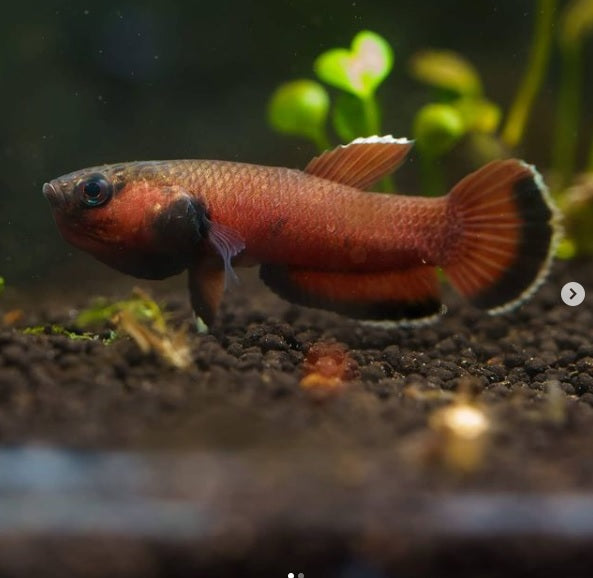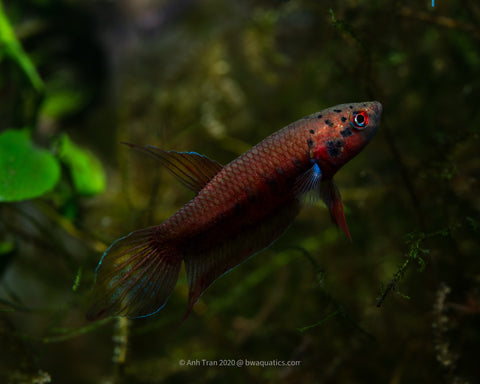
Easiest Wild Bettas to keep.
Share
Top 4 types of easiest Wild Bettas to keep.
Getting started on wild bettas can be a confusing and difficult process for those who are not used to keeping them. Though it is true that some wild bettas can be very sensitive, they can be as easy as domestic splendens found at the local pet store if you choose the correct ones. Below are my top choices for the easiest Wild Bettas to keep.
Betta Albimarginata/Betta Channoides


Channoides on top, Albiemarginata on the bottom.
Betta Albimarginata and Betta Channoides are small 25mm - 35mm wild Betta belonging to a complex that consist of two species both of which are native to the island of Indonesia in Kalimantan Timur. Albimarginata/Channoides inhabit tannins-rich forest streams with a slow flow rate at a very shallow depth (depth ~5-10 cm) containing leaf litter, branches, roots, and marsh plants. They are my number 1 choice for those who want to get their hands on trying wild bettas for the following reason.
Why they are good
Highly adaptable to different water GH and PH
Although almost all wild bettas enjoy soft acidic water, Betta Albimarginata/Channoides can easily adapt to tap or hard water. This means for many people who don't have a RO system they can get started on keeping wild bettas without one. Keep in mind that they still prefer softer water as the water in the native habitat has negligible GH and pH can dip below 6, so if you can and have the capacity to, you should keep them in that condition. It is important to note that if you do plan to keep them in harder tap water you need to follow basic instructions of dripping and accumulating the fish.
Low aggression towards their peers and other fish.
Unlike most of the bubble nesters and some mouth brooders, Betta Albimarginata/Channoides do not tend to fight their peers to the point of death. Given enough space, they can peacefully tolerate their kins and only occasional sparring. I have in my experience able to successfully keep trios in 2.5 gallons with no big issues and can even overstock the tank with some blackwater fishes such as Parosphromenus sp., though I do not recommend overstocking 2.5 gallon tanks unless the appropriate filtration system is provided. Aggressions from Albimarginata/Channoides are usually between males establishing their territory. These aggressive behaviors usually show themselves as flares displays typical of males in the Betta genus, however they tend to not lock jaws and severely injure one another. Showdowns typically end with nips from the dominant males and the subdominant fish will typically back off. Aggression between females is not as likely to happen as it is between males and large groups of females with a few males can be kept together in an appropriate size tank. Reverse trio can also be used as sometimes females can be picky when choosing their mate.
They are not good jumpers
Having betta jump to their death is something that almost all keepers will experience, from advance to beginners. I'm going to pretty much say this right now, if you are a beginner chances are you're going to lose your fish from jumping. Good thing is Albimarginata/Channoides are very poor jumpers and as long as you have 4 or more inches of empty space in your tank, they likely won't jump out. This means less stress and worries about losing a fish.
Why they are not good
Easily get sick
Unfortunately like all wild bettas they are easily prone to getting sick. Fungus infection, Columnaris, ich and velvet are all very deadly diseases. Most of the time, outbreak occurs from poor quarantine methods or a stressful environment. Make sure that you keep these fish in a stable environment, they are adaptable but still require stability.
Betta Rubra/Betta Dennisyongi


Dennisyongi on top, Rubra on the bottom.
One of the more iconic wild bettas, quite popular among people who want to dip their hands in their first mouthbrooding species. They are found in northwestern Sumatra, Indonesia with different locations offering different color patterns and intensity of “redness”. They are around 30-45mm and inhabit slow moving forest streams. They are my second-best choice for easy wild betta keeping.
Why they are good
Highly adaptable to different water GH and PH
Much like Albimarginata/Channoides Rubra/Dennisyongi can be adapted into different water parameters. This means for many people, they can get started on keeping them without the use of an RO system just make sure to drip accumulate them. Keep in mind that they still prefer softer water as the water in the native habitat has negligible GH and pH can dip below 6, so if you can and have the capacity to, you should keep them in that condition. Keep in mind though, that they need clean water.
Low aggression towards their peers and other fish.
Rubra/Dennisyongi are not very aggressive fish, just like Albimarginata/Channoides they don't usually fight to the point of death. But they are slightly more aggressive then the docile Albimarginata/Channoides. Most fights usually involve some form of flaring with a bit of chasing, typically between males but it can be between both sexes. Due to the low aggression, you can keep multiple pairs, trios, or reverse trios in the appropriate size tank. A 2.5-gallon is suitable for a pair and a 5 to 10-gallon is suitable for 2-3 pairs. Keep in mind that occasionally you have very aggressive males that can really injure the coinhabitant. If you want to make sure that this doesn't happen, be sure to remove the hyper-aggressive male. Aggression like this usually occurs in overstock tanks. Injured or stressed fish can easily get sick and have disease outbreaks. You can have tank mates, as long as the fish that you use as the tankmate isnt so small that it can fit in an adult male mouth. Small Boraras is something you want to avoid, but Chocolate gouramis are great!
Eat everything
These guys are not very picky eaters once they find out something is edible they can be easily fed. They are also big enough that they can take really small pellets or big pellets. Just make sure to not overfeed them as they can get bloated.
Easy to breed
Probably the easiest wild betta to breed, all you gotta do is put a male and a female together and chances are they will eventually have some babies. The best thing is, the babies are ready to eat BBS as soon as they hatch so they are also easy to raise.
Why they are not good
Incredible jumpers
Betta Rubra/Dennisyongi are very good jumpers. You gotta make sure every nook and crannies in your tank is covered up. That little space between the airline tube? Yeah, it's probably big enough for the fish to jump through. If you ever keep these guys, chances are you have woken up one day to some dried fish jerky.
Easily get sick
Even though they are highly adaptable to different water parameters, they are a magnet for disease. They can get sick very easily and the survival rate can be very low for sick fish. To make matters worse, if one fish gets sick it can very quickly spread to other fish. You want to make sure that they are in a stress-free environment as stress is the biggest factor in your fish getting sick.
Betta Dimidiata


Pair on top with male holding eggs, young male on the bottom.
Betta Dimidiata are a lesser known mouthbrooder betta that is excellent as an easy wild betta. Most people don't really know about them because they're availability is somewhat limited but they are a great species to keep and highly underrated. Dimidiatas are found in Putussibau, Indonesia and inhabit very shallow tannins stained swamp streams that have very low PH and are rich in leaf litter. They are around 35 – 40 mm but some individuals have very impressive finage that can extend past this length.
Why they are good
Easy to breed
These guys breed like rabbits, put some females and males together and they will soon mate with usually huge spawns. The only issue really is keeping them to hold for a period of time. Males are very timid and if they are not used to harsh lighting they can be stressed and swallow. That's why I advise those who like to breed them to keep them in a dimly lit environment with lots of hiding spots.
Low aggression
They are one of the most timid and less aggressive wild betta out there, groups of males can be together as long as there is adequate space. Males and females pairs can easily be housed in 2.5 gal but it is recommended that you keep a trio or a reverse trio in a 5 gallon.
Eat everything
These guys are easy to feed, once they realize that something is food they will greedily gobble it up. This makes feeding them easy, however, you also run the risk of making them bloat so always in moderation.
Why they are not good
Incredible jumpers
You gotta make sure every nook and crannies in your tank is covered up. Their timid nature makes them want to jump away from places they feel uncomfortable. They have pretty good vision too, most likely the result of living in a very dimly lighted habitat. Because of this, if there is a hole they will most likely find it.
Easily get sick
Unfortunately like many mouth brooding wild bettas, they are very prone to becoming sick. Not as prone as Rubra and albimarginata but because once they get sick it's very hard for them to recover. Velvet is very deadly and columnaris can kill them very quickly. So be sure that the environment that the fish is kept in is very stable.
Betta Antuta


Male full body, and close up of the head on bottom. Females are generally much duller
Betta Antuta are one of the largest mouth brooders out there, they can reach up to 100mm. Unlike most bettas, they inhabit highland streams in northern Indonesian Borneo where there can be a bit of water flow. Many people overlook these fish because of its size thinking that they’ll be difficult to keep but in actuality, they are quite hardy.
Why they are good
Highly adaptable to different water GH and PH
As long as stability and accumulation is taken into account, they can be adapted to living in most water conditions. Those without an RO system can still keep them in a higher PH environment without much of an issue. The real problem is making sure you accumulate them, they can get sick and die if they are exposed quickly to water parameters that they are not used to.
Low aggression
Despite their big size, they are actually one of the more peaceful large mouth brooding wild bettas. Males and females dont usually fight, but for some strange reason, they are aggressive toward their own sex. You can house a pair in a 5 gallon tank and if they're compatible they won't fight. That doesn't mean that occasionally you will encounter some aggressive ones. If you notice aggression between pairs, try swapping them out.
Eat everything
Probably the easiest fish to feed, they have big mouths so they can eat any variety of foods. Pellets like bug bites are my preferred choice when feeding these guys.
Why they are not good
Not good community fish
Even though these guys aren't really aggressive, they have really big mouths and because they are always looking for something to eat. Any fish that could fit into its mouth is fair game. These fish are best kept in a species-only tank.
Jumpers
They have pretty good vision, this only means that they can see the holes in your lids and if it's big enough they’ll jump it. Luckily they are pretty big so you have more leeway than you do with Rubra/dennisyongi, and if they are uncomfortable with their environment, they’ll most likely jump.

1 comment
Would it be possible to keep multiple males/females of antuta in a large 75 gallon tank?